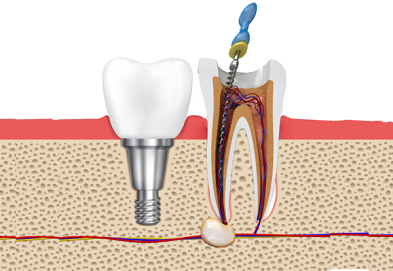Root Canal Vs Dental Implants
A popular question, there are two main ways to replace a missing tooth – via a dental implant or a fixed bridge. Both have their own set of advantages and disadvantages. Today, every effort is made to retain the natural tooth structure and root canal treatments enable us to do so. However, in some cases of extreme decay, trauma or fracture, it may not be possible to save the tooth and it mandates an extraction, followed by Implants. It is important in such cases to asses many factors such as bone health, health of adjacent tooth, time involved, surgical eligibility, finances and more. Let us explore these factors.
Treatment Time:
A dental bridge can be placed 2-3 weeks from the date of extraction of teeth. The typical dental implant requires two sittings, 3-6 months apart. In the first phase, the dental implant is placed, which then takes 3 to 6 months to integrate completely with the bone, otherwise known as osseointegration. Following this, a second stage minor surgery, exposes the implant and the procedures for the implant crowns can be carried out. During the healing phase, your dentist can provide you with a temporary to maintain aesthetics.
Involvement of adjacent teeth:
The fabrication of a dental bridge involves taking support from adjacent teeth structure, called abutments. To support a bridge, the adjacent teeth must be cut down to make space for the crowns. If either of the adjacent teeth need a dental crown or root canal treatment anyway, a bridge is a favourable option. However, if the teeth are of sound health, a dental implant should be preferred so as to not destroy the natural integrity of the teeth.
Surgery versus no surgery:
One of the main reasons for the debate between RCT versus implants is due to the fact that dental implants require surgery which is a frightening thought for many. However, a dental implant placement is a minor surgery that can be comfortably done under local anaesthesia. The dental implant surgery gets slightly complicated if there is less bone, which requires additional bone augmentation procedure like sinus lift procedures or ridge augmentation. Dental bridges on the other hand, ideally do not require any surgery. It should also be noted that in many cases surgery is contraindicated. In such cases, conventional crowns and bridges is the best option in fixed denture cases
Expense:
It goes without saying that dental implants are expensive. This is primarily due to the high cost of materials, demanding lab procedures, radiological and surgical costs. A dental bridge does not require 3D imaging techniques like CBCTs. In addition, many dental implants require additional particulate bone graft, which adds to the cost of the surgery. A bridge can be made with the help of a basic diagnostic X-ray. However, it must be noted that, in the event of microleakage and decay of the abutment teeth or poor periodontal health later on, in the worst case scenario, these teeth may also have to be extracted and replaced with implants, which in turn will be a bigger expense.
Maintenance:
Both dental crowns and bridges and dental implants require a thorough maintenance protocol for their longevity and optimum function. Stand alone dental implants are easier to maintain as adjacent teeth are not involved and a dental floss can be used to clean the narrow areas between teeth. The oral health maintenance protocol is same with single tooth dental crowns. However, with bridges, as the crowns are joined together, it isn’t possible to pass a floss between the teeth, which hamper cleaning and may lead to secondary decay.

